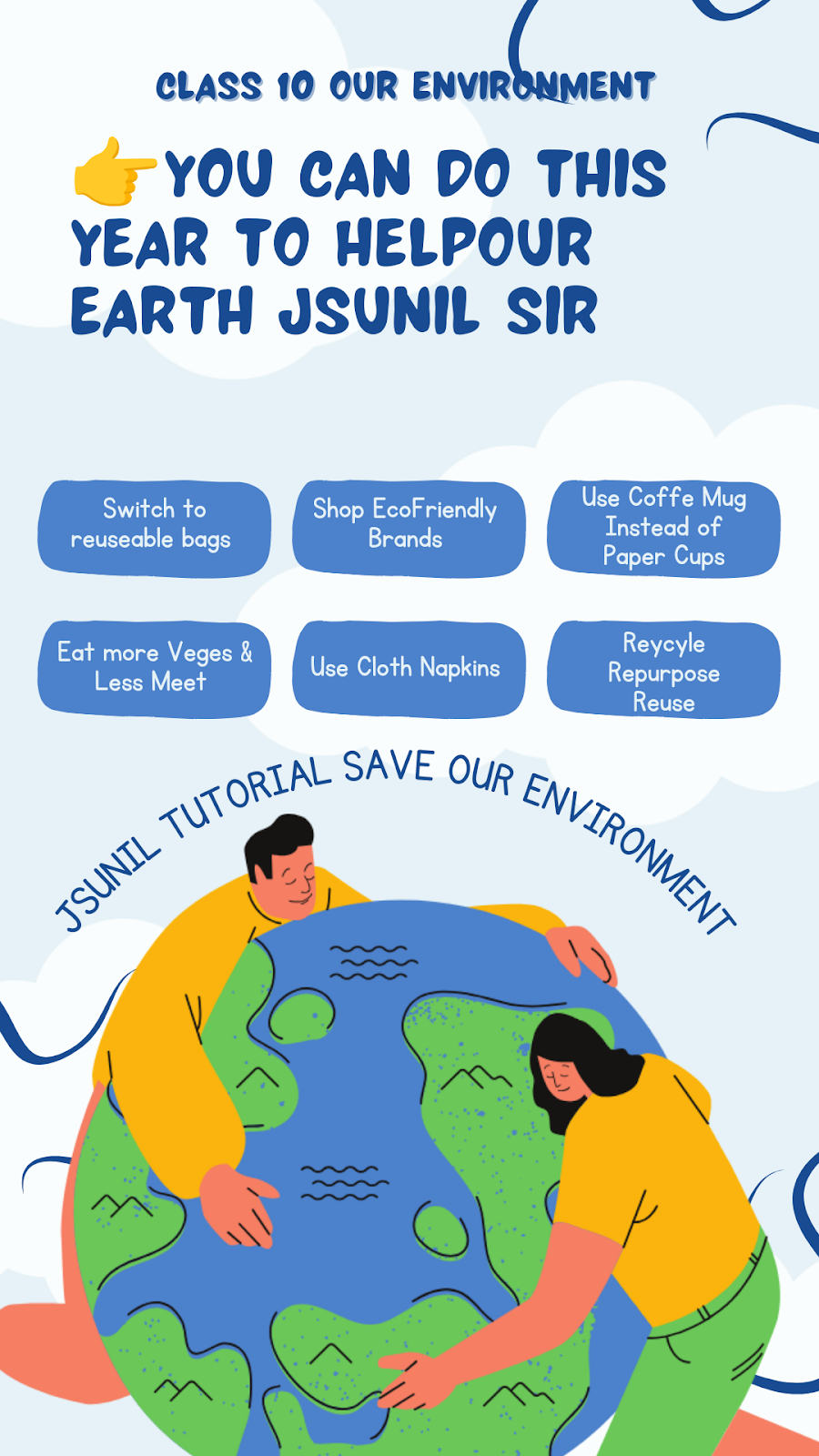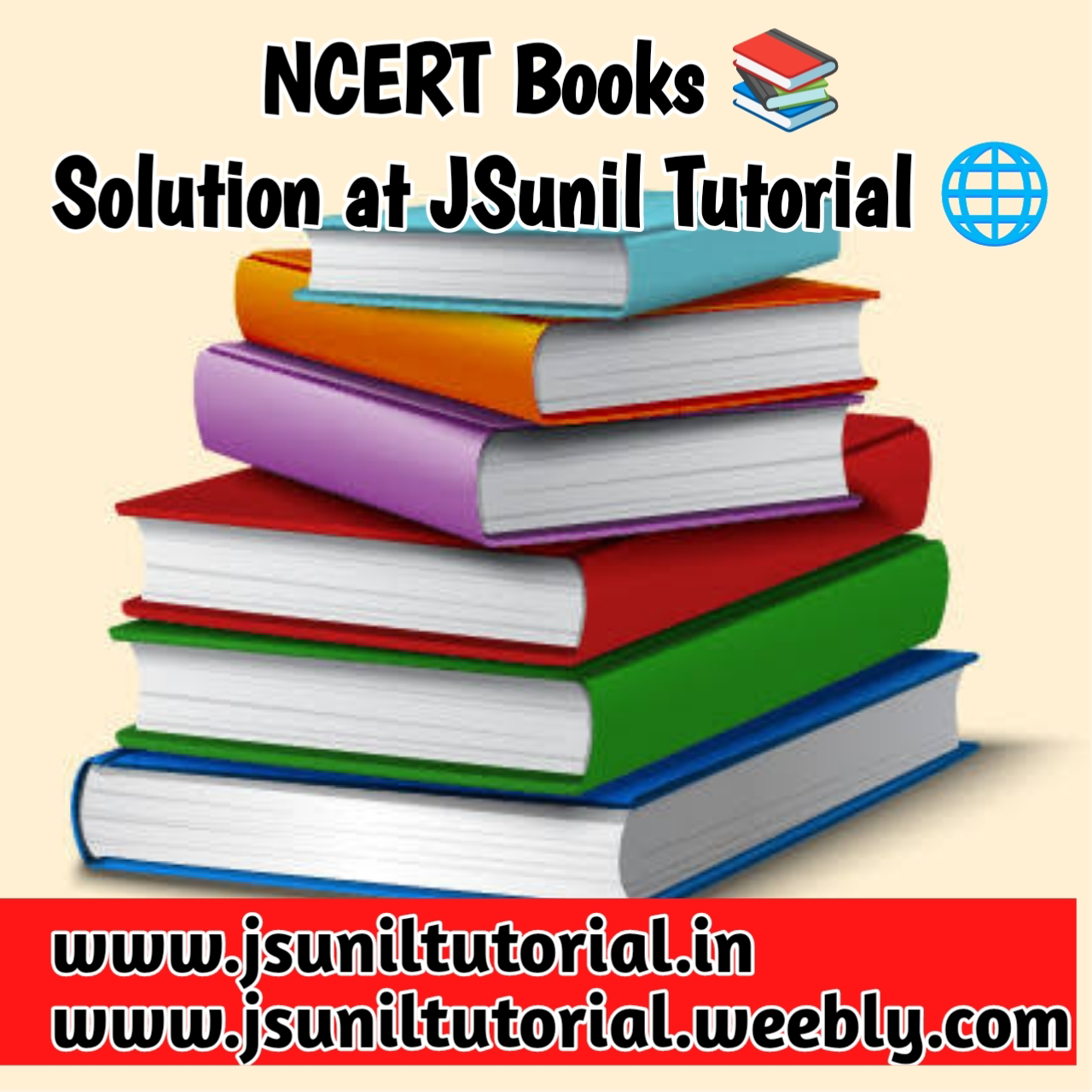class 10 ch 15 Our Environment CBSE Board Exam 2024
Exploring Our Environment: Class 10 Chapter 15 by Jsunil Sir
Our planet is a remarkable web of life, interconnected through ecosystems and intricate processes.
In Class 10 Science Chapter 15, "Our Environment," we delve into the fascinating world of ecological balance, environmental issues, and the ways we impact the world around us.
Let's embark on a journey to uncover the key topics of this chapter:
🌿 Ecosystems: The Harmony of Life
Ecosystems are the heartbeats of our planet.
Explore the delicate balance between living organisms and their physical surroundings.
From producers to consumers, food chains to trophic levels, understand how these systems function harmoniously to sustain life.
🌍 Environmental Problems: A Call to Action
As we've prospered, we've also posed challenges to our environment.
Dive into the discussion on environmental problems like pollution, deforestation, and global warming.
Discover the far-reaching impacts of these issues and their consequences on our planet and us.
🌫️ Ozone Depletion: A Fragile Shield
Unveil the intricate dynamics of ozone depletion, a phenomenon that has captured global attention.
Learn how human activities have contributed to the thinning of the ozone layer, leading to concerns about increased ultraviolet radiation and its effects.
♻️ Waste Production and Solutions
In a world of convenience, waste production has become a pressing concern.
Delve into the different types of waste, their sources, and their impact on the environment.
Explore innovative waste management solutions that aim to reduce, reuse, and recycle to minimize our ecological footprint.
🍃 Biodegradable vs. Non-Biodegradable
Understanding the distinction between biodegradable and non-biodegradable substances is crucial.
Explore how different materials interact with the environment over time.
Discover the importance of making conscious choices to minimize the accumulation of non-biodegradable waste.
🌱 Taking Action: Preserving Our Environment
The chapter concludes with a call to action. Explore ways individuals and communities can contribute to environmental conservation.
From sustainable practices to raising awareness, learn how we can collectively safeguard our planet for future generations.
As we navigate through "Our Environment," let's reflect on the interconnectedness of all life forms and our shared responsibility to protect and preserve the world we inhabit.
By understanding the intricate balance of ecosystems, addressing environmental problems, and making conscious choices, we can contribute to a healthier and more sustainable future for our planet.
So, join us on this educational expedition through Class 10 Chapter 15, and let's delve deeper into the fascinating realm of our environment.
Together, we can make a positive impact and foster a greener, healthier Earth.
#OurEnvironment #Class10Science #Ecosystems #EnvironmentalIssues #OzoneDepletion
Questions for your Board Exam
Q.1 (i) State the essential function performed by ozone at the higher levels of the atmosphere.(ii) Why was there a sharp drop in the amount of ozone in the atmosphere in 1980’s. (Board exam 2024
Ans: i) It shields the surface of the earth from harmful ultraviolet radiations of the Sun.
(ii) It was due to CFCs (Chlorofluorocarbons) which are used as refrigerants/ fire extinguishers / aerosols.
(ii) It was due to CFCs (Chlorofluorocarbons) which are used as refrigerants/ fire extinguishers / aerosols.
2.Write one difference between biodegradable and non-biodegradable wastes.
List two impacts of each type of the accumulated waste on environment if not disposed off properly.
Ans: Biodegradable wastes can be broken down by biological processes.
Non-biodegradable wastes cannot be broken down by biological processes.
• Impact of accumulated biodegradable wastes:
(i) Foul smell (ii) Breeding place for carriers of diseases (or any other)
• Impact of accumulated non-biodegradable wastes:
(i) Biological Magnification (ii) Affect soil fertility.
(or any other)
Q. List two methods of safe disposal of biodegradable domestic waste?
Ans: Safe Disposal:
Ans: Safe Disposal:
(a) Composting
(b) Putting in the green coloured bins.
3.“Although gardens are created by man but they are considered to be an ecosystem.” Justify this statement.
Ans: Gardens have biotic components like plants, and animals.
Ans: Gardens have biotic components like plants, and animals.
All these living organisms interact with each other and with abiotic components of ecosystem like water, air and soil.
4.In the following food chain, if 50 J of energy was available to the hawk, how much energy would have been present at the first and third tropic levels ? Justify your answer.
Grass --> Grasshopper---> Frog ---> Snake ---> Hawk
Ans: The energy at first trophic level will be 5,00,000 J.
The energy at third trophic level will 5000 J. 10% can be taken as the average value for the amount of organic matter/energy that is present at each step and reaches the next level of consumers
The energy at third trophic level will 5000 J. 10% can be taken as the average value for the amount of organic matter/energy that is present at each step and reaches the next level of consumers
5.How is ozone formed in the higher levels of the atmosphere ? "Damage to the ozone layer is a cause of concern." Justify this statement.
Ans: • UV radiations act on the oxygen molecule (O2) and then split oxygen molecule into free (nascent) oxygen.
• These free oxygen atoms combine with oxygen molecule (O2) to form ozone (O3)
Alternate answer: O2 ⎯⎯UV⎯→ O + O ;
Alternate answer: O2 ⎯⎯UV⎯→ O + O ;
O + O2 ⎯⎯→ O3
Damage to ozone layer :
• UV radiations reach the Earth and cause harmful effects like skin cancer in human beings.
6.State two reasons why human-made materials like plastics persist for a long time in the environment.
6.State two reasons why human-made materials like plastics persist for a long time in the environment.
Ans: Plastics are non-bio degradable. / Decomposers like bacteria and fungi cannot breakdown plastics into simpler substances.
They are inert substances. (or any other)
7.Explain how some harmful chemicals enter our bodies through the food chain.
Why is the concentration of these harmful chemicals found to be maximum in human beings ?
Ans.
Some harmful substances like pesticides are used to protect crops.
Some harmful substances like pesticides are used to protect crops.
When these chemicals are washed down in the soil or water bodies, they are absorbed by plants along with water and minerals and by animals from water. When we consume these food items, the pesticides enter our body.
As human beings occupy the top level in any food chain, maximum concentration of these chemicals get accumulated in them
8.Write the percentage of
(i) solar energy captured by the autotrophs and
(ii) energy transferred from autotrophs to the next level in a food chain.
Ans: a) (i) 1% (ii) 10% energy
9. What are trophic levels ?
Why do different food chains in an ecosystem not have more than four to five trophic levels ? Give reason.
Ans: Every step of a food chain where transfer of energy occur .
Since the amount and available energy keeps on becoming less as we move to higher trophic level, very little usable energy remains after four trophic levels.
10. Assertion (A) An ecosystem consists of biotic components and abiotic components.
Reason (R) : Biotic and abiotic components play important roles for the sustenance of life and work independently in all ecosystems.
Reason (R) : Biotic and abiotic components play important roles for the sustenance of life and work independently in all ecosystems.
(a) Both (A) and (R) are true and (R) is the correct explanation of (A).
(b) Both (A) and (R) are true, but (it) is not the correct explanation of (A).
(c) (A) is true, but (R) is false.
(d) (A) is false, but (R) is true.
Ans: C
11.Assertion (A) The energy which passes to the herbivores does not come back to autotrophs.
Reason (R) The flow of energy in a food chain is unidirectional.
(a) Both (A) and (R) are true and (R) is the correct explanation of (A).
(b) Both (A) and (R) are true, but (it) is not the correct explanation of (A).
(c) (A) is true, but (R) is false.
(d) (A) is false, but (R) is true.
Ans: A
Fore more exam material visit: Our Environment
Class 10 chapter Environment NCERT Solution Download File Class 10 our Environment cbse solved Test paper -1 Download File Class 10 our Environment cbse solved Test paper -2 Download File Class 10 our Environment cbse solved Test paper -3 Download File Class 10 our Environment cbse solved Test paper -4 Download File follow me : facebook.com/jsuniltutorial |





Comments
Post a Comment